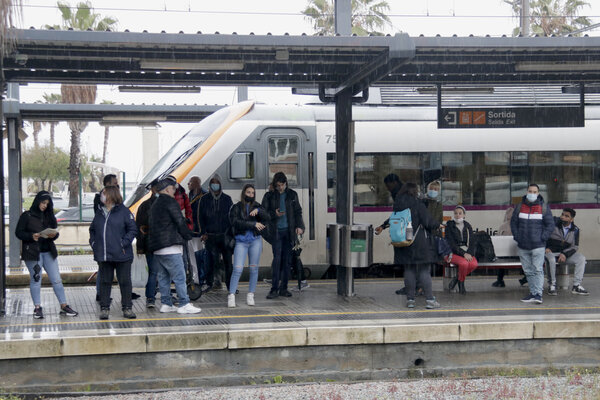The old railway and the sea: how climate change is affecting Catalonia’s Maresme line
Authorities resist calls from locals and environmental experts to move R1 tracks inland

How could businessman Miquel Biada have ever imagined in the 1840s that man-made climate change two centuries later would put his life’s work at risk? The first train line in Catalonia - and across Spain - was launched in 1848 between Barcelona and Mataró, his birthplace. The chosen route? By the sea, as picturesque as possible.
But now, rising sea levels and erosion caused by ports and the canalization of river streams have already partly swallowed beaches in Maresme, the county the R1 line crosses connecting Barcelona and Costa Brava. The train tracks and the N-2 highway that run parallel to it could soon be next.
Service can be far from reliable whenever there is severe weather as the water sometimes destroys the breakwaters that are supposed to protect the tracks, leading to delays and cancellations.
“The train line with its protective walls, the N-2 highway, and the buildings along the coast make it so that the coast’s natural system can’t work correctly, increasing erosion,” Joan Manuel Vilaplana, a geologist at the Geo-risk Observatory, told Catalan News. According to him, good, wide beaches would be the best form of protection against big storms, not rigid structures.
Storms are a relatively frequent phenomenon: in 2020, Gloria interrupted the service for days and destroyed a bridge between Pineda and Malgrat de Mar that took months to repair, while this March, part of the track bed was swept away.
Listen to our Filling the sink episode to learn more about this issue, you'll hear from locals, environmental experts, and politicians.
Incremental reform
The Spanish government, through its public companies Adif and Renfe, is in charge of the infrastructure, and locals demand action from them now.
Spain spent 12 million euros last year to put in an additional 2-km barrier between the tracks and the sea between Mataró and Cabrera de Mar. But experts, regional authorities, and neighbors like Antoni Esteban from the Preservem el Maresme association, think this isn't enough.
“Breakwaters are just ‘band-aids’ that last 2 to 3 years and then they’re gone,” Esteban argues. “Maresme county can’t take another Storm Gloria.”
Moving the line inland
For years, a possible solution has been up for debate: why not move the tracks inland?
Vilaplana believes this should be done first and foremost for safety purposes - for the line and train compartments, but also for passengers themselves.
But so far Spain has instead begun to pinpoint the line’s most critical, vulnerable spots and to build more protective barriers.
“It’s a very complex issue that is clearly long-term and astronomically expensive,” Xavier Flores, Spain’s infrastructure secretary general, argues. “We cannot lose sight of things that are urgent because of this kind of thing.”
Embarking on a huge and costly project that would require a multimillion-euro investment and many years, if not decades, of construction work, is still out of the question.
“Our politicians should think more about the people than about winning next year’s election,” Esteban charges. “They need to think about the long term.”
The Maresme county authority is planning to create a forum for the 30 affected towns in which they will try to find common ground. Should the line stay where it is, or should it be moved inland? Should it be managed by Spain or by Catalonia?
And so what does the future hold? The only thing everyone can seem to agree on is that the sea is swallowing the country’s oldest train line - something that would also be devastating for Maresme’s inhabitants and their livelihoods.